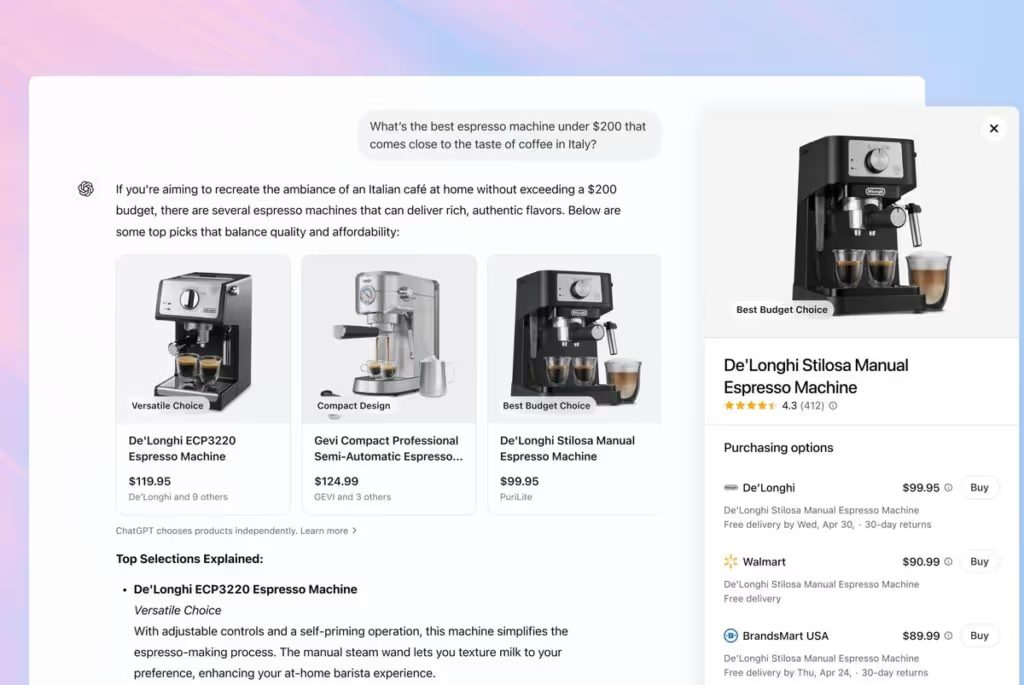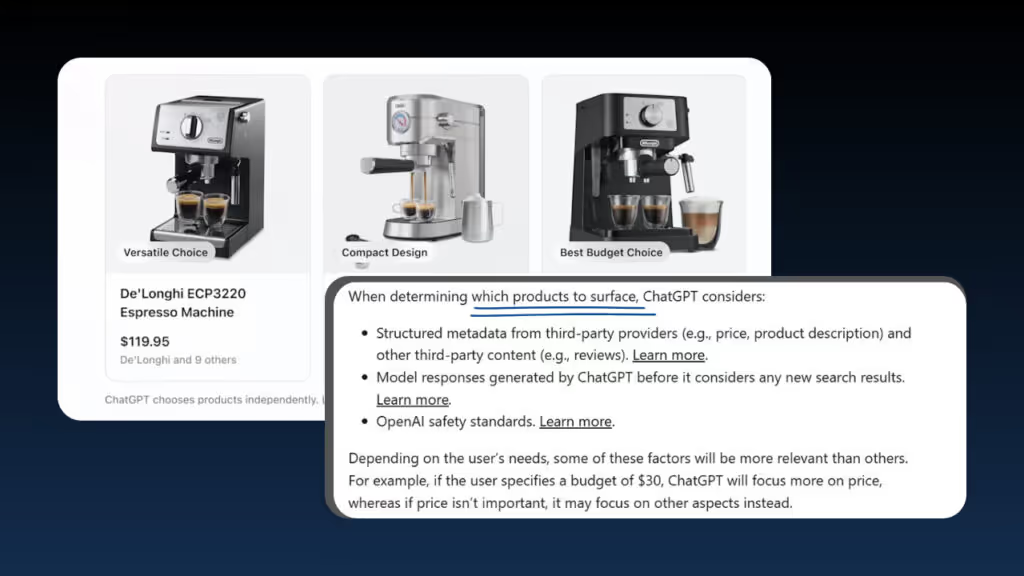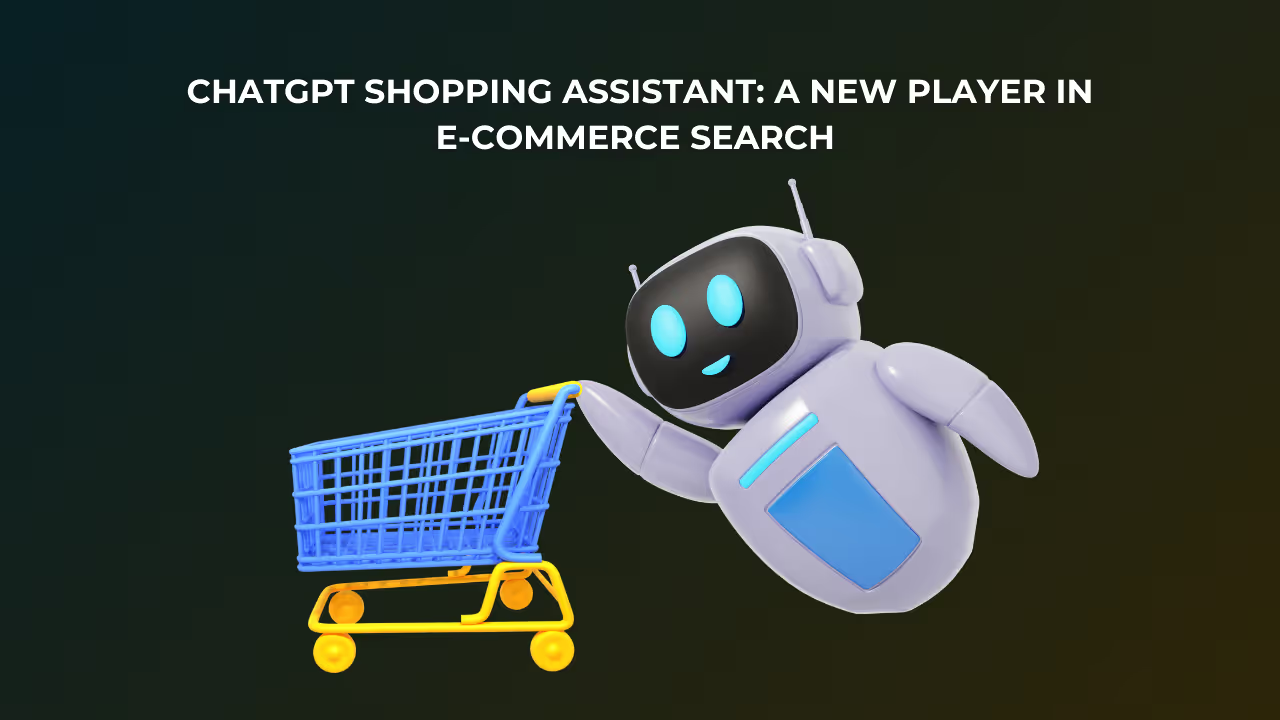Las compras online están cambiando (¡otra vez!). Esta vez, no por una nueva aplicación, mercado o tendencia social, sino por la forma en que las personas buscan. Si lo has estado observando de cerca, lo sabrás OpenAI agregó recientemente un Chat GPT asistente de compras, y aunque aún es pronto, ya está planteando grandes interrogantes para los profesionales del marketing.
Esta no es solo otra integración de chatbot. Es una señal de que el comportamiento de búsqueda está cambiando desde palabras clave y anuncios hasta descubrimiento de productos conversacional e impulsado por la IA.
Analicemos lo que esto significa para los profesionales del marketing y las marcas que intentan mantenerse relevantes en un panorama digital en constante evolución.
¿Qué es el asistente de compras de ChatGPT?
La nueva Asistente de compras ChatGPT permite a los usuarios buscar productos en lenguaje natural. En lugar de escribir «los mejores auriculares económicos con cancelación de ruido», un usuario podría simplemente preguntarse: «¿Cuáles son los mejores auriculares con cancelación de ruido por menos de 150 dólares?» y obtén un carrusel de resultados de los productos, con imágenes, precios, descripciones, reseñas y enlaces para comprar.
La función ya está disponible para todos los usuarios, incluso sin una cuenta, y cubre categorías como moda, electrónica, artículos para el hogar y belleza. No ofrece pago directo (al menos no todavía), pero está diseñado para reducir la fricción en el proceso de compra poniendo recomendaciones directamente en el chat.
En este momento no hay prácticas remuneradas. Los productos se seleccionan en función de intención, datos del producto y preferencias del usuario (para usuarios de Plus y Pro con memoria habilitada).

ChatGPT Shopping vs Google Shopping vs Perplexity AI: ¿en qué se diferencia?
ChatGPT shopping no es la primera herramienta de inteligencia artificial que ayuda a los usuarios a comprar. Pero su integración en una IA conversacional existente que ya tiene más de mil millones de consultas semanales hace que valga la pena examinarlo.
Así es como se compara:
Conclusiones clave para los especialistas en marketing
- La personalización está evolucionando: Google usa datos históricos para la personalización. ChatGPT usa conversaciones almacenadas (para los usuarios suscritos), lo que podría generar sugerencias más adaptadas al contexto con el tiempo.
- Sin anuncios = sin atajos: Sin colocaciones pagas, no puedes comprar visibilidad (por ahora). Esto hace que el enfoque pase a calidad del contenido, metadatos del producto y reputación.
- Sin búsqueda visual (todavía): A diferencia de Google y Perplexity, ChatGPT no admite consultas basadas en imágenes. Si tu producto se basa en el atractivo visual, es posible que esto limite el descubrimiento por ahora.
- Checkout no es nativo: Los usuarios aún tienen que ir al sitio web del minorista para completar la compra, lo que significa que no hay una experiencia sencilla con un solo clic, como en algunas plataformas.
Qué significa esto para la estrategia de comercio electrónico
Desde un punto de vista práctico del marketing, la aparición del asistente de compras de ChatGPT nos empuja a repensar algunas cosas:
1. El SEO tradicional no será suficiente
Probablemente hayas optimizado tus PDP y tus datos estructurados para Google. Eso sigue siendo importante, pero las herramientas de inteligencia artificial, como ChatGPT, no rastrean las páginas de la misma manera. Extraen el significado, sintetizan las reseñas y resumen los beneficios.
Aquí es donde LLMO (optimización de modelos de lenguaje grande) entra. Se trata de:
- Estructuración clara de los ficheros de productos (títulos, especificaciones, disponibilidad)
- Incluye lenguaje centrado en el usuario y preguntas frecuentes
- Mantener la calidad de las reseñas y el sentimiento del producto de manera uniforme
2. El reconocimiento de marca podría importar menos
A los LLM no les importa si tu marca es conocida, están diseñados para sugerir lo que es relevante, bien revisado y claramente descrito. Si confías únicamente en la autoridad de la marca, podrías perder visibilidad frente a competidores más optimizados.
3. Las rutas de conversión están cambiando
ChatGPT shopping no ofrece pago nativo (todavía), pero sí actúa como filtro en la parte superior del embudo. Los usuarios ahora pueden iniciar su investigación aquí en lugar de Google o Amazon. Si no participas en estas primeras conversaciones, ya estás fuera de la carrera.
¿Esto afectará al marketing de afiliados y de contenidos?
Es muy posible.
Si los consumidores encuentran lo que necesitan directamente en ChatGPT, especialmente con recomendaciones imparciales, los editores afiliados pueden perder tráfico. Del mismo modo, los blogs que se basan en contenido SEO de Google de alto nivel pueden generar menos participación si los usuarios evitan por completo los motores de búsqueda.
Esto no significa que el marketing de contenidos esté muerto. Simplemente significa que el contenido debe ser:
- Estructurado para la interpretación de la IA (claro, conciso, objetivo)
- Diseñado para responde a las preguntas, no solo clasifica las palabras clave
- Centrado en fomentar la confianza y la claridad, no es un lenguaje comercial
Entonces, ¿qué deben hacer los especialistas en marketing ahora?
Esta es una breve lista de acciones que tienen sentido ahora, incluso si no estás preparado para revisar tu estrategia de comercio electrónico.

Optimice los datos de los productos para la IA:
- Usa títulos descriptivos y viñetas.
- Mantenga la coherencia de los datos en todas las plataformas.
- Resalta las opiniones de los usuarios y las especificaciones clave.
Pon a prueba tu visibilidad:
- Test the products indications in ChatGPT.
- Comprueba si se menciona a tu marca o a tus competidores.
- Ajusta los listados o los mensajes en función de lo que recomiende la IA.
Si estás llevando a cabo campañas multiplataforma, herramientas como Dataslayer puede ayudar a automatizar el proceso de elaboración de informes, lo que te permite supervisar el rendimiento en Google Shopping, Meta Ads y otras fuentes clave, para que puedas centrarte en optimizar lo que realmente mueve la balanza.
No abandones el SEO, hazlo evolucionar:
- Sigue optimizando para Google, pero empieza a experimentar con contenido compatible con LLM.
- Actualiza las publicaciones del blog y las páginas de productos para responder mejor a las preguntas reales de los usuarios.
Reflexiones finales
El lanzamiento del Shopping Assistant ChatGPT no se trata de reemplazar a Google o dominar el comercio electrónico de la noche a la mañana. Pero sí sugiere hacia dónde se dirige el comportamiento de los usuarios: hacia experiencias de compra más intuitivas, personalizadas y menos impulsadas por la publicidad.
Como especialistas en marketing, debemos prestar atención. Ya lo hemos visto antes: cuando los dispositivos móviles cambiaron la experiencia de usuario, cuando el marketing de influencers modificó la confianza y las decisiones de compra, y cuando TikTok cambió el descubrimiento de productos. Este es otro cambio, y quienes se adapten pronto estarán mejor posicionados para atender a los clientes donde realmente están comprando, no solo donde solían hacerlo.







